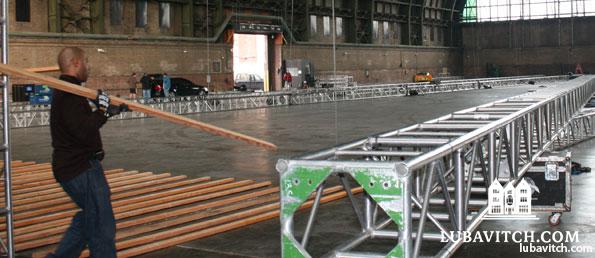(lubavitch.com) The non-descript building occupying a square block on Bedford Avenue in Brooklyn, draws little attention of passersby and local residents. But this Sunday evening, thousands will file into the Troop C Armory for the banquet session, concluding the International Conference of Shluchim.
When Lieutenant Paul Grout petitioned the Ways and Means Committee for $150,000 to house his cavalrymen, he can hardly have pictured the troops who would dine in his drill hall 109 years later.
It has taken nothing short of an army of producers, construction workers, designers, and electricians working over many months to transform the cavernous drill hall to seat 4,000 guests for dinner.
The convention committee runs into the same predicament each year: even in America’s largest, busiest city, it is hard work finding a place to seat so many people. In the early years of the conference, the several hundred or so rabbis who traveled to New York each fall could easily be accommodated in the local yeshiva’s social hall. When their numbers multiplied, the banquet moved to the Marriot Hotel in Brooklyn and then, when they outgrew that, to Manhattan hotels. Last year, thousands of guests made their way to Pier 94 on the Hudson River.
But for this year’s event, marking 70 years since Chabad-Lubavitch relocated its headquarters in Brooklyn, it made sense to make the culminating event, if not in spitting distance, at least an easy walk from 770 Eastern Parkway. Guests can reach the dinner via a 10-minute pleasant stroll under Eastern Parkway’s autumn overhang.
“Our move this year to the Armory in Brooklyn represents an important connection with the neighborhood where the American branch of Chabad began,” says David Scharf of DS Productions, who has been producing the banquet even for years, and has watched it grow.
The armory is still used by the military: the National Guard has offices inside and humvees are stored in the building’s garage (they were rolled out to accommodate the event’s lobby). In recent years, it has also often been used as a movie set.
Last spring, Chabad’s delegation lobbied the state for permission to rent the armory. They hired an architect who drew up blueprints, outlining the applicable zoning laws and the convention’s needs. Because the armory’s drill hall has an official maximum capacity of only 500 people, Scharf worked with the U.S. Division of Naval and Military Affairs to bring the building up to code and add emergency lighting and signs, to accommodate the 4,000 expected guests.
Jason Scharf recently graduated with a degree in business from Yeshiva University. Now the 20-something works as his father’s executive assistant. He sits in the front hall’s makeshift office, recording new arrivals, coordinating the deliveries, and trying to keep his cool.
Before he arrived here at the beginning of the week, the younger Scharf spent months on the phone getting quotes and hiring the sanitation, security, rental, video, and lighting companies.
“This year we made an extreme effort for everything to be frugal in light of the economy,” he says. “In addition to the company I actually hired, I got quotes from at least three others.” With a little ingenuity, Scharf managed to cut many of the evening’s costs in half.
By the time visitors arrive at five o’clock Sunday evening, signs of the hall’s previous uses will have been camouflaged beyond recognition. The transformation—months in the making—came to a head the week before the banquet.
Crews arrived Monday at six in the morning, many working 22-hour shifts. Despite the long hours and physically challenging labor, workers said they were happy to be on site. (Maintaining a positive attitude, and a ready smile, was the only way things could work, said one contractor.)
Metal trusses for the lighting and sound systems were positioned tens of feet above the ground. Fourteen enormous screens across the room’s walls were installed, then re-installed them when they weren’t deemed perfectly in place. On Thursday morning, green and white construction trucks maneuvered around piles of round tables and rolls and rolls of carpeting. Crews respond immediately to endless instructions shouted out in a handful of different languages.
When the room is complete, 350 round tables, covered in alternating blue and ivory tablecloths will rest on the burgundy-colored carpeting. As the program opens, all eyes will settle on the street-scene before them: the podium is designed to look like the exterior of 770, complete with a brick façade, street lamps, and leafy trees.
“The hall is still not large enough,” says Rabbi Moshe Kotlarsky, exhausted after months of preparation and still struggling to accommodate a guest list that seems to grow by the minute. “But I trust that the banquet event will give the Shluchim an inspired sendoff before they head back to their communities.”
Preparing the multi-course, elegant dinner is another feat. Food will be prepared in a commissary and then delivered to the armory on Sunday morning. Hundreds of waiters from four employment agencies will serve the thousands of guests. In recent weeks, full background checks were completed on each employee.
Security, in the wake of last year’s terrorist attack in Mumbai and due to current tensions, is a significant concern. A private security firm will work with the NYPD and a volunteer community patrol to secure the area. Guests will be required to go through metal detectors before entering the hall.
This, however, is not the type of crowd to let security concerns put a damper on the evening. From every corner of the globe, and every individual community, these men prove that despite setbacks, small and sometimes severe, there is a mission to accomplish. On Sunday, they will cheer their successes as they look to the future.
It is a fighting crowd. Lieutenant Grout and his men would be proud to welcome them here.
Click here to watch the banquet live, Sunday, Nov 15, 5:30pm

Be the first to write a comment.